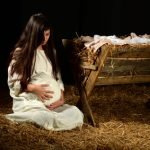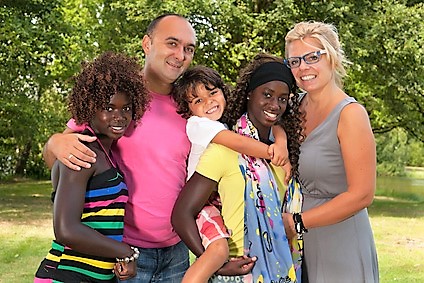The influence of Christmas surrounds us whether it is part of one’s faith tradition and beliefs or not. Most people probably “know” the Nativity story— even non-Christians. This blog written by GIFT coach and Lutheran minister, Sally Ankerfelt, continues our look at the Nativity through an adoption lens. The Chrismas story may trigger questions and concerns for adoptees. Sally offers parents insights to help them reassure their children through the season. While her thoughts flow through a faith-based filter, there are insights for all adoptive families regardless of their faith tradition.
 In the next week or two, congregations across the nation will present the traditional “Christmas Pageant.” The birth of Jesus will be re-enacted by the youngest of the fold. You may even have a child who will be a part of this play, dressed up as a shepherd, a wise man, Mary or Joseph.
In the next week or two, congregations across the nation will present the traditional “Christmas Pageant.” The birth of Jesus will be re-enacted by the youngest of the fold. You may even have a child who will be a part of this play, dressed up as a shepherd, a wise man, Mary or Joseph.
In our last blog, we asked, “What do our (adopted) children see and experience at Christmas?” We talked about the popular image of The Holy Family being tight-knit, cozy, warm, and a model of what a faithful family should be.
Yet, for our adopted children and, perhaps, for us as adoptive families, we may struggle to see how we fit into this picture. Even worse, adoptive children and families may see how they fall short of this ideal family.
But, a closer look at the story of Jesus and his birth reveals an almost opposite picture of The Holy Family. In fact, the real, non-Christmas-pageant family has elements that adoptive children and families may quickly recognize.
First, Mary and Joseph were not a traditional couple. In fact, from the human eyes of Mary and Joseph, this pregnancy was unplanned and scandalous. Joseph had the notion to “dismiss [Mary] quietly” and go on with his life. He was asked by God to parent this child which was not his. Joseph takes on the role of dad, loving and claiming Jesus as his own. Does this sound familiar? Already, we see in the story an element of adoption, that in the mind of God, a father can have a son whose parentage is different.
Mary also is a woman who is asked to bear someone else’s child. From the time the angel tells her she will bear the Savior of the World, she recognizes that this child belongs to God.
 Second, the Holy Family is transient. Mary and Joseph wander far from their home in Nazareth to Bethlehem, a city of strangers. There, they look for a place to give birth and experience many closed doors before an inn-keeper sees their need. For adoptive families who have searched and traveled far, Mary and Joseph’s experience may ring true. For adoptive children who have been in foster care and moved from place to place, the transient and uncertain nature of where the infant Jesus will finally “lay down its sweet head” (from the carol, Away in a Manger) may bring a note of recognition.
Second, the Holy Family is transient. Mary and Joseph wander far from their home in Nazareth to Bethlehem, a city of strangers. There, they look for a place to give birth and experience many closed doors before an inn-keeper sees their need. For adoptive families who have searched and traveled far, Mary and Joseph’s experience may ring true. For adoptive children who have been in foster care and moved from place to place, the transient and uncertain nature of where the infant Jesus will finally “lay down its sweet head” (from the carol, Away in a Manger) may bring a note of recognition.
When we tell these parts of the Christmas story, we as adoptive children and families may see ourselves. From the beginning, this Holy Family is a family formed with people on the margins and in difficult situations. The story is layered with what it means to be family and with an understanding that “family” means more than just a tight-knit nuclear unit.
The amazing thing about this manger story is that it does not end on that Holy Night, when the traditional Christmas pageant curtains close. Jesus continues to introduce us to a new type of family, one defined by declaration, love, and loyalty.

That baby in a manger and his parents are indeed a Holy Family. But, they are not the kind of Holy Family we often see at pageants and in pictures. This Holy Family is holy because it reflects the messiness of life while expanding our definition of what it means to be family. Families can be created in unique and haphazard circumstances. Families can be more than birth parents and children. They can include other parents, as well (foster parents, step parents, etc.). And families formed simply by declaration that shows they are, indeed, fully parents and children, and are just as much a family as any.
I encourage those who are celebrating Christmas to read your children the Christmas story. As you go along, pause in your telling, gently offering this background information to your children. Questions of curiosity can introduce the ideas, such as “Did you know that Mary and Joseph and baby Jesus were like our family? Joseph and Mary were the dad and mom, but God was, too.” Or “Did you know that Mary and Joseph were afraid to be parents because they knew that they had a child that they had to share with God?” or “I wonder what Jesus felt growing up, knowing he had Mary and Joseph as his parents but God as his parent, too.”
The questions themselves can do the teaching while we, as adoptive parents, do the watching, listening and validating.
Letting our children know that they have a place in the Christmas story may bring a new experience of Christmas: inclusion rather than exclusion, a confirmation that even families that have loss as a part of their beginnings are just as beautiful, real, and holy as any other.



Writing a response to this post — notice it is January 10 and the blog post was December 14 — because why not?! I feel like I am playing catch up — the holidays came and went and somehow I feel like I missed them. So …
As 2017 begins, this is a great opportunity to reflect on our own families. Perhaps we are not the traditional family, perhaps our children have experienced uncertainty and transience, and maybe we continue to have difficult situations to work through, but as you said, the Christmas Story can continue to remind us, even as we begin a new year, that our adoptive families are as “legitimate” as any other. #adoptivefamilies, #AAQ, #adoption